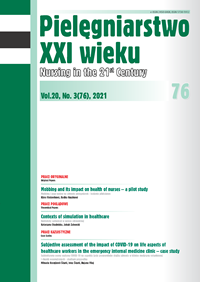Nurses’ views on and compliance with the guidelines of hand hygiene, including nail hygiene in a multi-profile hospital in Lesser Poland Province – the evidence for need of continuous education and training
DOI:
https://doi.org/10.2478/pielxxiw-2021-0029Keywords:
hand hygiene, nails, nail covers, continuing education, healthcare-associated infections preventionAbstract
PERCEPTION AND PRACTICE Of HH AND NURSES EDUCATIONAL NEEDS
Aim. The aim of this study was to examine the current situation and potential needs for education aiming at improving Polish nurses’ views and attitudes in terms of compliance with hand hygiene guidelines.
Material and methods. The study was based on a diagnostic survey method. A questionnaire based study and also visual evaluation of the nurses’ nails was carried out as well.
Results. Our results reveal unsatisfactory nurses’ attitudes and compliance with the given area of hand hygiene recommendations. Especially, despite the nurses’ strong support for natural nails, in practice they did not always comply with the guidelines.
Conclusions. It is necessary to develop and implement effective strategies of continuing education and training aiming at changing habits of healthcare workers, including nurses, in hand hygiene.
References
1. World Health Organization. WHO Guidelines on Hand Hygiene in Health Care. First Part. Global Patient Safety Challenge. Clean Care is Safer Care. Geneva,Switzerland: WHO Press; 2009.
2. Foca M, Jakob K, Whittier S, et al. Endemic Pseudomonas aeruginosa infection in a neonatal intensive care unit. N. Engl. J. Med. 2000: 343(10):695-700.
3. McNeil SA, Foster CL, Hedderwick SA, et al. Effect of hand cleansing with antimicrobial soap or alcohol-based gel on microbial colonization of artificial fingernails worn by health care workers. Clin. Infect. Dis. 2001; 32(3): 367-372. Epub 2001 Jan 18.
4. Gordin FM, Schultz ME, Huber R, et al. A cluster of hemodialysis-related bacteremia linked to artificial fingernails. Infect. Control. Hosp. Epidemiol. 2007; 28(6): 743-744. Epub 2007 Apr 19.
5. Rayan GM, Flournoy DJ, Schlageter P. Microbiological flora and nail polish: a brief report. J. Okla. State Med. Assoc. 1994; 87(11): 504-505.
6. Baumgardner CA, Maragos CS, Walz J, et al. Effects of nail polish on microbial growth of fingernails. Dispelling sacred cows. AORN J. 1993; 58(1): 84-88.
7. Wynd CA, Samstag DE, Lapp AM. Bacterial carriage on the fingernails of OR nurses. AORN J. 1994; 60(5): 796, 799-805.
8. Arrowsmith VA, Maunder JA, Sargent RJ, Taylor R. Removal of nail polish and finger rings to prevent surgical infection. Cochrane Database Syst. Rev. 2001; 4: CD003325.
9. Fagernes M, Lingaas E. Factors interfering with the microflora on hands: a regression analysis of samples from 465 healthcare workers. J. Adv. Nurs. 2011; 67(2): 297-307. doi: 10.1111/j.1365-2648.2010.05462.x. Epub 2010 Oct 15.
10. Hardy JM, Owen TJ, Martinez SA, et al. The effect of nail characteristics on surface bacterial counts of surgical personnel before and after scrubbing. Vet Surg. 2017; 46(7): 952-961. doi: 10.1111/vsu.12685. Epub 2017 Jun.
11. Wałaszek MZ, Kołpa M, Różańska A, et al. Nail microbial colonization following hand disinfection: a qualitative pilot study. J. Hosp. Infect. 2018 Jun 30. pii: S0195-6701(18)30360-8. doi: 10.1016/j.jhin.2018.06.023.
12. Piwowarczyk J. Badanie wpływu różnych czynników na jakość skuteczność mikrobiologiczną procedury higienicznej dezynfekcji rąk wśród personelu medycznego. Rozprawa doktorska. Wrocław: Uniwersytet Medyczny we Wrocławiu, 2014.
13. Hautemaniere A, Cunat L, Diguio N, et al. Factors determining poor practice in alcoholic gel hand rub technique in hospital workers. J. Infect. Public Health. 2010; 3(1): 25-34. doi: 10.1016/j.jiph.2009.09.005. Epub 2010 Feb 11.
14. Ubheeram J, Biranjia-Hurdoyal SD. Effectiveness of hand hygiene education among a random sample of women from the community. J. Prev. Med. Hyg. 2017; 58(1): E53-E55.
15. Loveday HP, Wilson JA, Pratt RJ, et al. epic3: National Evidence-Based Guidelines for Preventing Healthcare-Associated Infections in NHS Hospitals in England. Journal of Hospital Infection. 2014; 86S1: S1–S70.
16. Wałaszek M, Kołpa M, Różańska A, et al. Practice of hand hygiene and use of protective gloves: Differences in the perception between patients and medical staff. Am. J. Infect. Control. 2018: pii: S0196-6553(18)30070-1. doi: 10.1016/j.ajic.2018.01.025.
17. Rosiński J, Różańska A, Jarynowski A, et al. Factors Shaping Attitudes of Medical Staff towards Acceptance of the Standard Precautions. Int. J. Environ. Res. Public. Health. 2019; 16(1050): 1-10 https://www.mdpi.com/1660-4601/16/6/1050
18. Różańska A, Wójkowska-Mach J, Bulanda M. Work experience and seniority in health care vs. Medical students’ knowledge of selected hand hygiene procedures. Med. Pr. 2016; 67(5): 623-633.
19. https://www.who.int/gpsc/core-components.pdf
20. Baumagarder CA, Maragos CS, Walz J, et al. Effects of nail polish on microbial growth of fingernails. Dispelling sacred cows. AORN J. 1993; 58(1): 84-88.
21. Parry MF, Grant B, Yukna M, et al. Candida osteomyelitis and diskitis after spinal surgery: an outbreak that implicates artificial nail use. Clin. Infect. Dis. 2001; 32(3): 352-357. Epub 2001 Jan 24.
22. Hewlett AL, Hohenberger H, Murphy CN, et al. Evaluation of the bacterial burden of gel nails, standard nail polish, and natural nails on the hands of health care workers. Am. J. Infect. Control. 2018; 46(12): 1356-1359. doi: 10.1016/j.ajic.2018.05.022. Epub 2018 Jul 6.
23. Kingston LM, Slevin BL, O’Connell NH, et al. Hand hygiene: Attitudes and practices of nurses, a comparison between 2007 and 2015. Am. J. Infect. Control. 2017; 45(12): 1300-1307. doi: 10.1016/j.ajic.2017.08.040. Epub 2017 Oct 16. PMID: 29050908.
24. Martos-Cabrera MB, Mota-Romero E, Martos-García R, et al. Hand Hygiene Teaching Strategies among Nursing Staff: A Systematic Review. International Journal of Environmental Research and Public Health. 2019; 16(17): 3039. https://doi.org/10.3390/ijerph16173039.
25. Kanneganti A, Sia CH, Ashokka B, et al. Continuing medical education during a pandemic: an academic institution’s experience. Postgrad. Med. J. 2020; 96(1137): 384-386. doi: 10.1136/postgradmedj-2020-137840. Epub 2020 May 13. PMID: 32404498.
Downloads
Published
Issue
Section
License
Copyright (c) 2021 Authors

This work is licensed under a Creative Commons Attribution-NonCommercial-NoDerivatives 4.0 International License.




